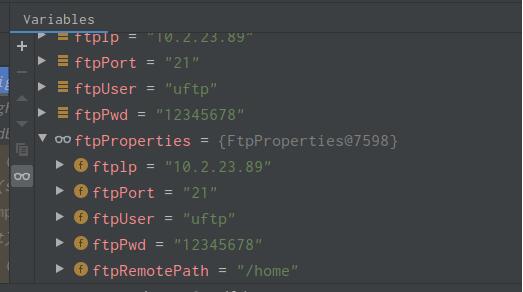Spring中使用@Value注解给bean加载属性的配置文件有两种使用方式
第一种:使用@Value("#{configProperties['websit.msgname']}")
spring中配置属性加载文件的配置方式
|
1
2
3
4
5
6
7
|
<bean id="configProperties" class="org.springframework.beans.factory.config.PropertiesFactoryBean"> <property name="locations"> <list> <value>classpath:/properties/websit.properties</value> </list> </property></bean> |
注意
1.这里使用的configProperties必须要和定义的bean名称一致。
2.websit用来指定msgname来源于那个配置文件
3.配置的加载属性bean名称为org.springframework.beans.factory.config.PropertiesFactoryBean
第二种:使用@Value("${websit.msgname}");
使用这种方式,又可以有两种配置方式
方式一
|
1
2
3
4
5
6
7
8
9
10
11
|
<bean id="propertyConfigurer" class="org.springframework.beans.factory.config.PreferencesPlaceholderConfigurer"> <property name="properties" ref="configProperties"/></bean> <bean id="configProperties" class="org.springframework.beans.factory.config.PropertiesFactoryBean"> <property name="locations"> <list> <value>classpath:/properties/websit.properties</value> </list> </property></bean> |
方式二
|
1
2
3
4
5
6
7
|
<bean id="propertyConfigurer" class="org.springframework.beans.factory.config.PropertyPlaceholderConfigurer"> <property name="locations"> <list> <value>classpath:properties/websit.properties</value> </list> </property></bean> |
当使用@Value注解bean属性时,如果没有在配置文件中配置,这时启动spring就会抛出异常。@Value提供了一种默认值的设置方式,如果在属性文件中没有配置则可以使用默认值。
形式如下
|
1
2
|
@Value("${avg.age:22}") private int userAge; |
如果使用@Value注解后,数据不能正常的被注入则需要在xml的配置文件中加入下列代码
|
1
|
<context:annotation-config/> |
SpringBoot使用注解(@value)读取properties(yml)文件中 配置信息
为了简化读取properties文件中的配置值,spring支持@value注解的方式来获取,这种方式大大简化了项目配置,提高业务中的灵活性。
1. 两种使用方法
1)@Value("#{configProperties['key']}")
2)@Value("${key}")
2. 配置文件示例
ftp:
ftplp: 10.2.23.89
ftpPort: 21
ftpUser: uftp
ftpPwd: 12345678
ftpRemotePath: /home
说明:以上是配置文件中的信息,主要是一些账号密码等信息。
3. 读取yml配置文件的工具类
|
1
2
3
4
5
6
7
8
9
10
11
12
13
14
15
16
17
18
19
20
21
22
23
24
25
26
27
28
29
30
31
32
33
34
35
36
37
38
39
40
41
42
43
44
45
46
47
48
49
50
51
52
53
54
55
56
57
58
59
60
61
|
package com.dbright.dataprediction.entity;import org.springframework.beans.factory.annotation.Value;import org.springframework.boot.context.properties.ConfigurationProperties;import org.springframework.context.annotation.PropertySource;import org.springframework.stereotype.Component;@Component@PropertySource("classpath:ftpconfig.yml")@ConfigurationProperties(prefix = "ftp")public class FtpProperties { @Value("${ftplp}") public String ftplp; @Value("${ftpPort}") public String ftpPort; @Value("${ftpUser}") public String ftpUser; @Value("${ftpPwd}") public String ftpPwd; @Value("${ftpRemotePath}") public String ftpRemotePath; public String getFtplp() { return ftplp; } public void setFtplp(String ftplp) { this.ftplp = ftplp; } public String getFtpPort() { return ftpPort; } public void setFtpPort(String ftpPort) { this.ftpPort = ftpPort; } public String getFtpUser() { return ftpUser; } public void setFtpUser(String ftpUser) { this.ftpUser = ftpUser; } public String getFtpPwd() { return ftpPwd; } public void setFtpPwd(String ftpPwd) { this.ftpPwd = ftpPwd; } public String getFtpRemotePath() { return ftpRemotePath; } public void setFtpRemotePath(String ftpRemotePath) { this.ftpRemotePath = ftpRemotePath; }} |
说明:以上是使用@value注解来读取yml配置文件的代码示例
1)@component —— 把普通pojo实例化到spring容器中,相当于配置文件中的`<bean id="" class=""/>`
2) @PropertySource("classpath:ftpconfig.yml") —— 设置yml文件的路径,方便扫描到。一般我们配置文件都是放在resources包下。所以我们只需要 classpath+所需要读取的配置文件名称。
3)@ConfigurationProperties(prefix = "ftp") —— 这个不需要解释太多,配置文件里面内容的前缀,我们读取的是ftp下的信息。
4)@Value("${ftplp}") —— 这是读取我们所需的配置信息,美元符号+{字段名}即可制定
5)下面定义字符串来接收所读取到的配置信息。
6)写set和get方法,方便外部类调用。
4. 演示:效果图如下


可以看到,我们成功取到了我们想要的值。
5. 一开始说的第二种和这个差不多
把{}外的 $ 变成 # 号,然后里面指定配置文件的信息+字段而已。大同小异,我就不贴代码上来了。
今天的内容就到这里啦,以上为个人经验,希望能给大家一个参考,也希望大家多多支持服务器之家!
原文链接:https://blog.csdn.net/huangjianghong6816/article/details/78748119















